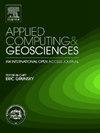Extracting data from maps: Lessons learned from the artificial intelligence for critical mineral assessment competition
IF 3.2
Q2 COMPUTER SCIENCE, INTERDISCIPLINARY APPLICATIONS
引用次数: 0
Abstract
The U.S. Geological Survey (USGS), Defense Advanced Projects Research Agency (DARPA), Jet Propulsion Laboratory (JPL), and MITRE ran a 12-week machine learning competition aimed at accelerating development of AI tools for critical mineral assessments. The Artificial Intelligence for Critical Mineral Assessment Competition solicited innovative solutions for two challenges: 1) automated georeferencing of historical geologic and topographic maps, and 2) automated feature extraction from historical maps. Competitors used a new dataset of historical map images to train, validate, and evaluate their models. Automated georeferencing pipelines attained a median root-mean square error of 1.1 km. Prompt-based extraction (i.e., with user input) of polygons, polylines, and points from geologic maps yielded median F1 scores of 0.77, 0.56, 0.35, respectively. Geologic maps pose numerous challenges for AI workflows because they vary significantly. However, despite its short duration, the competition yielded promising results that have since spurred further innovation in this area and led to the development of new AI tools to semi-automate key, time-consuming parts of the assessment workflow.
从地图中提取数据:从关键矿物评估竞争的人工智能中吸取的经验教训
美国地质调查局(USGS)、国防高级项目研究局(DARPA)、喷气推进实验室(JPL)和MITRE进行了为期12周的机器学习竞赛,旨在加速开发用于关键矿物评估的人工智能工具。关键矿物评估人工智能竞赛针对两个挑战征集创新解决方案:1)历史地质和地形图的自动地理参考,以及2)历史地图的自动特征提取。参赛者使用历史地图图像的新数据集来训练、验证和评估他们的模型。自动地理参考管道的均方根误差中值为1.1公里。从地质图中提取多边形、折线和点(即用户输入)的基于提示的F1得分中值分别为0.77、0.56和0.35。地质图变化很大,给人工智能工作流程带来了许多挑战。然而,尽管比赛持续时间很短,但取得了令人鼓舞的成果,这些成果刺激了该领域的进一步创新,并导致了新的人工智能工具的开发,以实现评估工作流程中关键、耗时部分的半自动化。
本文章由计算机程序翻译,如有差异,请以英文原文为准。
求助全文
约1分钟内获得全文
求助全文
来源期刊

Applied Computing and Geosciences
Computer Science-General Computer Science
CiteScore
5.50
自引率
0.00%
发文量
23
审稿时长
5 weeks
 求助内容:
求助内容: 应助结果提醒方式:
应助结果提醒方式:


